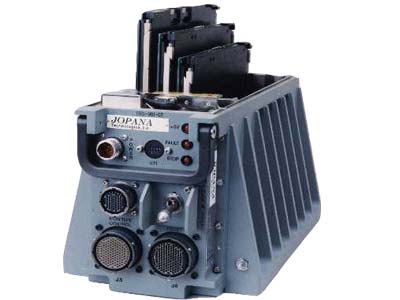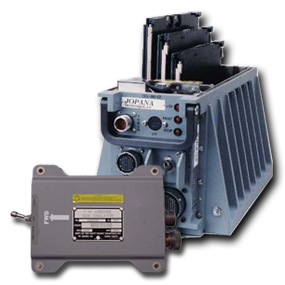
Airborne Data Reduction System (ADRS)
The Airborne Data Reduction System (ADRS) represents the future of airborne instrumentation and data reduction in a system readily available today. It has been designed and developed by Jopana Technologies, Inc., under the direction of the Naval Air Warfare Center, Weapons Division (NAWC-WPNS), and is currently installed in the Navy's F-14A/B and F-14D "Tomcat" aircraft stationed at Point Mugu, CA. The ADRS is an in-flight data reduction system that provides an immediate post-flight analysis capability of the instrumented aircraft without the delay and expense of tape processing or digital data post-flight downloading.
The ADRS is a cost effective solution to any instrumentation acquisition system requirement. It collects multiple data sources and, in real-time, formats them into a user definable format and writes the data to a ruggedized SCSI hard drive, thus bypassing the need to perform any post processing procedures prior to analysis. In the F-14 installation, the ADRS is used to replace an analog tape recorder system. This resulted in the elimination of extensive tape support and maintenance, slow and costly post-processing, and an entire data processing infrastructure required to support data analysis. This dramatically improved the data quality (due to direct digital processing and recording), as well as instrumentation reliability in all air combat maneuver (ACM) environments since the initial installations in 1996.
The ADRS is housed in a half-size air transportable rack ( ATR) short chassis and is capable of simultaneously processing up to eight MIL-STD-1553B avionics buses and a single 1Mbps pulse code modulated (PCM) data stream. Additional inputs include an Inter-communications audio system, multiple serial interface streams, and various discrete signals, such as BCD timecode for time synchronization with external systems. A configuration is available to output a 1 Mbps PCM stream for telemetry (TM) transmission, which is programmable to output user defined parameters via a TM lookup table.
The field programmable front-end circuits and RISC processors format the data in real-time for storage into the customer standard file formats on an external tactical SCSI 4GB or 9GB hard disk. This feature allows play-back of flight test data on any SCSI equipped data analysis workstation immediately after flight.
The processing power of the ADRS is comprised of an SBS/or Computers ruggedized 486 processor board (the RPC) , which serves as the overall system controller, and ruggedized Data Formatter and Telemetry boards, made by Jopana Technologies, that handle all data interface and formatting. The ADRS standard data format is Domain Manufacturing's (previously BBN) PROBE STD format for use on either a VMS or Windows NT operating system, but is capable of providing the data in any user requested format and for most operating system platforms.
The ADRS has the flexibility of operating in various data collection configurations without the need for reprogramming. An external configuration plug at the ADRS monitor/control port allows its operation to be changed without having to reload or re-program the unit. This feature proves valuable when sharing a unit between aircraft, as different configurations can be accommodated by simply changing the configuration plug. For extensive changes or software modifications, a portable Memory-Loader-Verifier (MLV) unit is available to easily update the aircraft.
The primary data processing element in the ADRS is the Data Formatter Board (DFB), a 6U VME board based around a 66-MHz embedded RISC processor, which translates the various digital data input types into a common data format for storage to the SCSI disk. It is comprised of two primary sections; (1) the Computer Processing section, and (2) the Data Acquisition section. Extensive use of programmable logic devices is incorporated throughout the design, which allows for easy modification and upgrades. The programmable logic easily allows the hardware to be reconfigured for different functions, most notably to monitor and translate different data types without having to make hardware changes.
The Telemetry Board (TMB) is a modified version of the DFB, which adds the capability to output a user-definable 1Mbps telemetry stream. The TMB accepts two 1553B data channels, as well as BCD timecode inputs for external time synchronization (e.g. an IRIG Time Code source). It uses programmable logic devices as well, which enables flexibility in defining the parameters incorporated in the TM output stream.
With the addition of an external ruggedized SCSI hard disk, the ADRS is a self-contained system which can be combined with other instrumentation systems to fully monitor aircraft system operation. For example, in the block diagram below, the ADRS is combined with a PCM encoder unit and a video recorder to form a single unit instrumentation pallet for installation in fleet configured F-14A/B/D aircraft. This system is remotely operated via two control lines, and has three discrete outputs to provide operational status indications, however, the availability of an RS-422 interface ports provides the possibility of remote terminal operation as well.


